Sous Vide cooking is appealing because it promises restaurant level results in the comfort of your own home. By maintaining a constant, precisely-controlled temperature, you don’t have to worry about overcooking expensive steaks or delicate seafood. The previously esoteric cooking method is gaining popularity, and circulators are being designed with the home cook in mind. Picking (and paying for) such a fancy kitchen toy can be a little daunting, but we’re here to help.
The Contenders
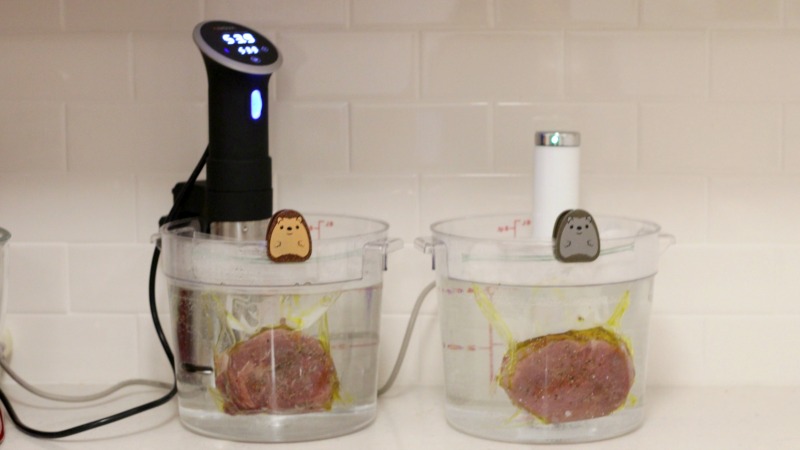
Dueling steaks
We’ll be looking at two models of sous vide immersion circulators: the current darling and the new kid. (Full-disclosure: I have an Anova, which my mother bought me for Christmas, and I love it dearly. The ChefSteps model I’m testing is the Beta version, sent to me by the company, and — as much as it pains me to do so — I will be sending it back when I’m done testing it out.)
- Anova Precision Cooker ($259 for WiFi enabled model, $235 for Bluetooth enabled model): The Anova Precision Cooker has been the sous vide device to buy for some time now, with many of the top voices in home cooking singing its praises.
- ChefSteps Joule ($US299 ($400), or $US205 if you pre-order): Seattle-based cooking site ChefSteps is releasing their own device in September, and it looks like a worthy contender to the sous vide throne. [Note: The company currently doesn’t ship outside of the US, but plans to soon. You can sign up to receive updates about availability in Australia. In the meantime, your best bet is eBay or a US forwarding postal service like Shipito.]
To compare the two devices we looked at their design, functionality, ease of use and storage, and — of course — cooking ability.
The Hardware: The Joule Is Smaller and Mightier, but Absolutely Requires the App to Use
If you are going to be spending hundreds of dollars on a kitchen appliance, it had better be a nice kitchen appliance, and size, weight, power, and aesthetics all play a role here. Let’s check out some specs (and videos!)
The Anova:
- Dimensions: The Anova has a height of 36.8 cm and a width of 6.98 cm.
- Weight: 1kg
- Clip: The adjustable clip on the Anova works well for any pot or plastic food container, but can be a little wobbly when attached to coolers or anything with an irregularly shaped edge.
- Display: Unlike the Joule, the Anova has a digital display which tells you target temperature, current temperature, and cooking time. Though cooking times and temperatures can be set through the app, you can also manually set the temp using the little wheel on the Anova, meaning you can sous vide even if you don’t have a smartphone.
- Power: 800 W
- Maximum Temperature: 210F/99C
- Maximum Volume:The Anova can heat up to 19 litres of water.
- Immersion Depth: 8cm
- Wi-Fi: Yes, if you get the Wi-Fi enabled model. This feature allows you to control the circulator from anywhere with wireless internet, which I tested by going to the bar and preheating the water from there. (The future is now.)
The Joule
- Dimensions:
- Weight: 0kg
- Clip: The Joule is equipped with a simple wireform clip that fits on almost any kitchen pot or container, but it also features a powerful magnet that attaches to any steel or induction-ready pot, meaning you can run the Joule clamp-free.
- Display: There is no real display on the Joule, just a little light that flashes yellow when the water is heating, green when it’s ready to cook, and red if there’s a problem. I actually missed having a digital readout on the device itself, and didn’t love the fact that I couldn’t control the Joule at all without opening the app, but that may be because I am terrible at keeping my phone charged.
- Power: 1100 Watts.
- Maximum temperature: 194F/90C, but ChefSteps is still testing safety features at higher cooking temperatures.
- Maximum volume: 20 litres in an open pot or container, 40 litres in a closed, insulated system such as a cooler.
- Immersion Depth: 5cm-8 inches
- Wi-Fi: Yes
The Joule has the advantage of being the newer unit, and it shows it by edging the Anova out in quite a few categories. It’s lighter and smaller, which makes it easier to operate and store, and it just looks sleeker and sexier. (On a scale from “1 to ChefSteps co-founder Grant Crilly,” I give the Joule as solid 7.7.)
Though it is small, the Joule is mighty, and that extra 300 watts translates into less pre-heating. To test out just how much less, I heated two buckets of water (4 litres each) from room temperature to 56 degrees Celcius (the temperature recommended for cooking a steak medium-rare). The Joule got there in about 10 minutes, and the Anova took twice as long. The Joule also has a slightly higher maximum volume and a slightly wider immersion range, though the Anova can heat water 16 degrees (F) hotter than the Joule.
All of that being said, I do not enjoy the fact that you have to operate the Joule from the app. I appreciate the techy, “internet of things” aspect of it all, but I am klutzy, forgetful person who often loses, drops, and forgets to charge her phone. Having my sous vide depend so heavily on my phone makes me nervous, as a damaged phone now means more than a damaged phone; it also means I can’t use my sous vide. (Plus, there’s the fact that there are still people out there who don’t have a smartphone or tablet, and that should preclude them from the delicious magic of sous vide cooking).
The Apps: Both Apps Are Well Designed and Get the Job Done
Then there are the apps for your phone. For the Anova, the app (available for free for iOS and Android) is technically optional, and I’ve cooked many a thing without ever opening it. When it comes to the Joule, you absolutely cannot operate the thing without the app (also free, for iOS and Android, but not until the device launches,) but the app itself is pretty excellent.
The Anova
The Anova app comes packed with recipes and time and temp guides, including some that were developed and perfected by J. Kenji Lopez-Alt of Serious Eats. For foods that can vary in doneness, like steak or eggs, there are options letting you choose how rare you want your steak and how runny you want your eggs.
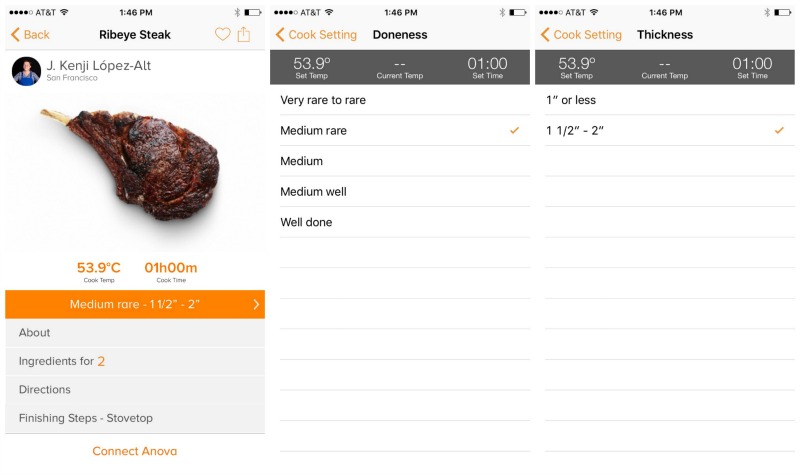
In addition to the Serious Eats guides, there are also a bunch of recipes written by cooks and food writers alike, ranging from limoncello to pumpkin pie.
The Joule
Like the hardware before it, the software for the Joule is a little sexier too. In addition to letting you set temperature and time based on recipe, the Joule has a “visual doneness” scale for most foods, letting you cook an egg based on how you would like the white and yolk to look, rather than using words. You can also choose “fresh” or “frozen” for your meats, meaning you can chuck a steak in straight from the freezer.
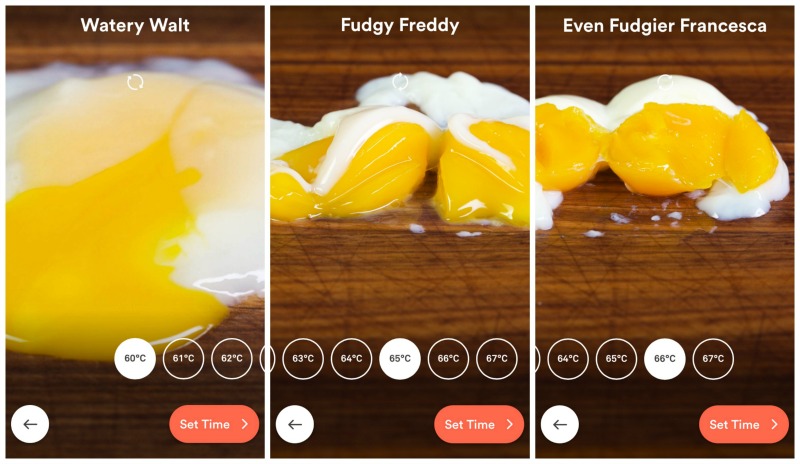
The guides are divided into “basic” and “ultimate,” but you can also search by type of food. Sadly, the app doesn’t contain every sous vide recipe ever perfected by ChefSteps. To find those, you have to go to the ChefSteps site, which makes some amount of sense, considering how often ChefSteps releases a new sous vide recipe.
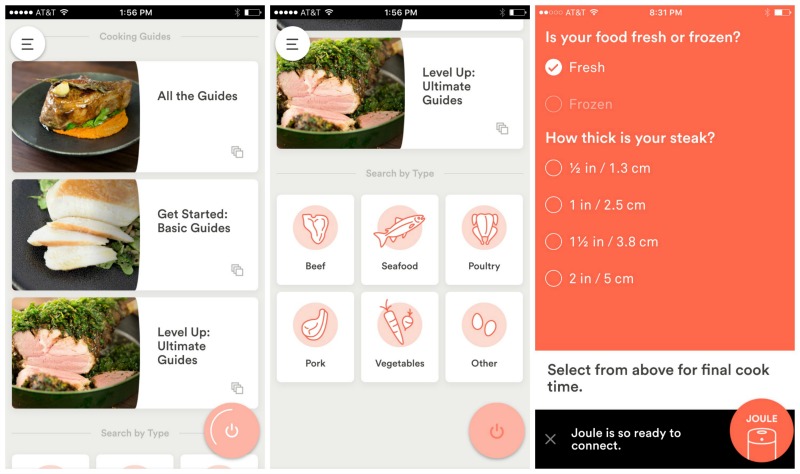
The Steaks: Everybody Wins When Sous Vide Is Involved
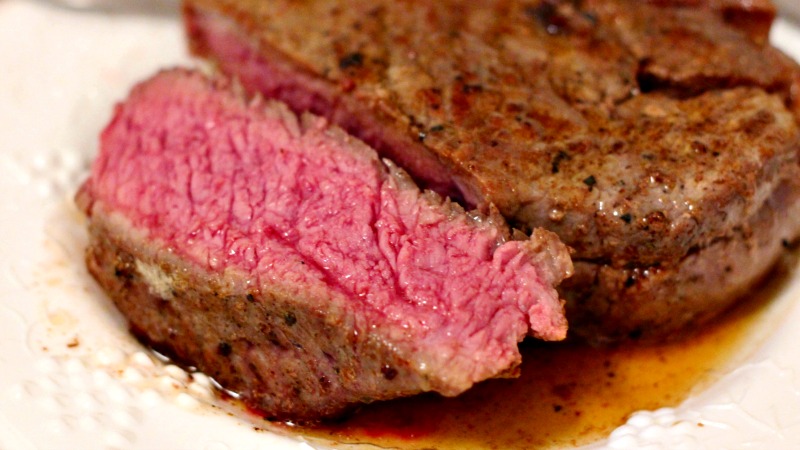
They pretty much both looked like this.
Now we get to the most important feature: the cooking. To test out the cooking ability of each circulator — and to give myself an excuse to buy two ribeyes — I cooked two almost identical steaks side by side, following the instructions in their respective apps. (I did however omit the recommended rosemary and garlic, and opted to keep the seasoning simple with just a bit of olive oil, salt, and pepper.)
Both turned out medium-rare and delicious, and were perfectly pink from edge to edge, the steak cooked using the Joule’s instructions was just slightly more done than the one cooked using the Anova, but that makes sense when you consider that the Joule has your steak hang out in the water for an additional half hour. I was thrilled with both of them.
The Verdict: The Joule Is Your Culinary Apple to Anova’s Microsoft
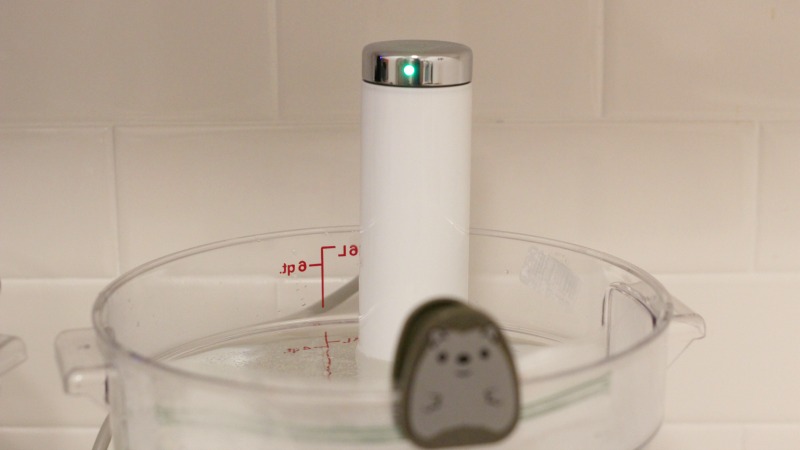
The winner!
Here’s the thing: both the Joule and the Anova produce beautifully cooked food. The Joule is smaller, a bit more powerful, and a bit easier on the eyes, but it’s also a hundred dollars harder on the wallet, so it’s a matter of what you want to spend your money on. (Actually, if you get in on the pre-sale, it’s only sixteen bucks harder on the wallet, so act fast if you want the Joule.) Basically, the Anova is Microsoft, and the Joule is Apple. The Joule is a bit hipper, the app is a bit prettier and easier to use — and that whole “visual doneness” thing is slick as heck — but the Anova will still get the job done.
It’s also worth pointing out that you can use ChefSteps’ and Anova’s recipes no matter what sous vide circulator you own, though you may have to plug in the temps and times yourself rather than sending them from your phone.
All of that being said, I’m going to have to award the win to the Joule, and not just for aesthetic reasons. The smaller size and streamlined design makes this thing way easier to store and the extra power cuts down on preheating wait times. I’m not going to get rid of my Anova any time soon, but if I was in the market for a new sous vide, I’d get the Joule, especially at that sweet pre-sale price.)
Photos by Claire Lower.
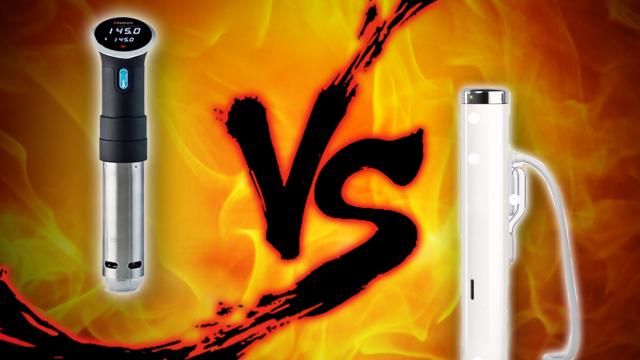
Comments
2 responses to “Sous Vide Showdown: The Anova Vs. The Joule”
For people who are looking to dip their toe into the tepid water bath that is sous vide cooking, I’ve been able to get some outstanding results using something like this http://www.ebay.com.au/itm/like/271869105763?lpid=107&chn=ps along with a slow cooker.
I built my own with an arduino and it works pretty well. Doesn’t circulate but in a rice cooker that doesn’t seem to matter much. It holds the temp to around 1c or less. Have done some great 24hr briskets, steaks, fish. Maybe I’ll get one of these fancy ones down the track but at the moment this will do me.
Have to say though that if I had seen that device on fleabay I would def have opted for that. Plug and play.
http://www.instructables.com/id/Cheap-and-effective-Sous-Vide-cooker-Arduino-power/?ALLSTEPS
“but that makes sense when you consider that the Joule has your steak hang out in the water for an additional half hour.”
No it does not make sense. By definition, sous vide cooks up to the set temperature, then stays there. A steak at 132F for one hour or 3 will have the exact same doneness. The meat might be a little more tender, from protein breakdown, but will still be the exact same 132 medium rare. If you experienced a difference in doneness, either one recipe was too short and did not cook the meat up to temp, or, the temperatures on the units aren’t exactly calibrated the same (accuracy was not tested??), or the steaks were not cut from the same larger piece (did you have the butcher cut them right then?).
Thanks for the test! How did you manage to use the Joule? I’m thinking about the 110v vs 240v issue. Did you use a stepdown transformer? Cheers
Hi there. I am also interested in the answer to this question. Also whether it was a problem that we use 50Hz whereas US uses 60Hz? Cheers!